Full of vibrant landscapes, interesting temples and tasty food, Vietnam is one of the best places to go on holiday. On the coastline of the Indochina peninsula, Vietnam has many wonderful places to visit such as Halong Bay and Sapa. It also is home to many tasty kinds of food like Spring rolls, Banh-mi, and Pho (noodle soup).
This December, my family visited North Vietnam for 10 days. I hope you enjoy reading this post and finding out more about this wonderful holiday destination
Day 1: Hanoi – Arrive in Hanoi, walk around West Lake
Day 2: Hanoi – Ho Chi Minh Mausoleum, Thang Long Imperial Citadel, Vietnamese Museum of Ethnology
Day 3: Ninh Binh – Hoa Lu Ancient Capital, Mua Caves, Trang An
Day 8: Sapa – Rong May Glass Bridge, Gates of Heaven, Cat Cat Village
Day 9: Return to Hanoi
Day 10: Fly back to Singapore
Hanoi: 2 day itinerary
We landed at Noi Bai airport, Hanoi in the afternoon. It was an hour’s drive from there to the Sheraton, our hotel. Because it was winter, the weather was pretty cold. The city was super busy and noisy and there were lots of cars and two wheelers everywhere. Our hotel was in a much quieter area of the city, pretty much isolated from everything else.
After dinner, we took a walk around the West Lake, the biggest lake in Hanoi, right outside the Sheraton, to stretch our legs. There were lots of restaurants selling different kinds of cuisines like Mexican and Italian. These restaurants are mainly for tourists. In Hanoi, there are so many cars on the road that buzz around you like a swarm of bees. If you’re too scared to cross the road, my tip is to close your eyes so that you don’t see anything, raise your hand and cross!
Our first day in Hanoi, after breakfast, we took a cab to the Ho Chi Minh mausoleum where the body of General Ho Chi Minh (lovingly called Uncle Ho) was embalmed after he passed away. Because it was a weekend, the queue was super long, so we decided to go to the museum about Ho Chi Minh and just view the mausoleum from outside.
I learned that Vietnam used to be ruled by the French but the Vietnamese wanted independence, so under the guidance of General Ho, Vietnam became independent, but was split into two countries in the North and the South. A war for unification broke out between the North and South in 1955. The US supported the South and Russia supported the North. General Ho, who was now president of North Vietnam, helped them in the war until he died in 1969. The North won the war in 1975 and Vietnam became a communist nation. The capital of South Vietnam, Saigon was renamed as Ho Chi Minh City in his honor.
There were also lots of school children who were there on a class trip and had stopped to pay their respects to Ho Chi Minh. A few of them waved at us and tried to converse with us in English – they seemed very friendly.




Next we went to the Thang Long Imperial Citadel, the royal quarters of the Ly dynasty, located in the old capital of Vietnam, Thang Long (present day Hanoi). There are lots of performances hosted here nowadays. We saw a dragon dance practice, going on in preparation for the Lunar New Year. Much of the citadel has been destroyed, and only a few buildings remain. This included a giant gate, which served as the entrance to the imperial citadel. The complex also housed the Hanoi Flag tower, a tall tower made of stone with the flag of Vietnam flying at the top.
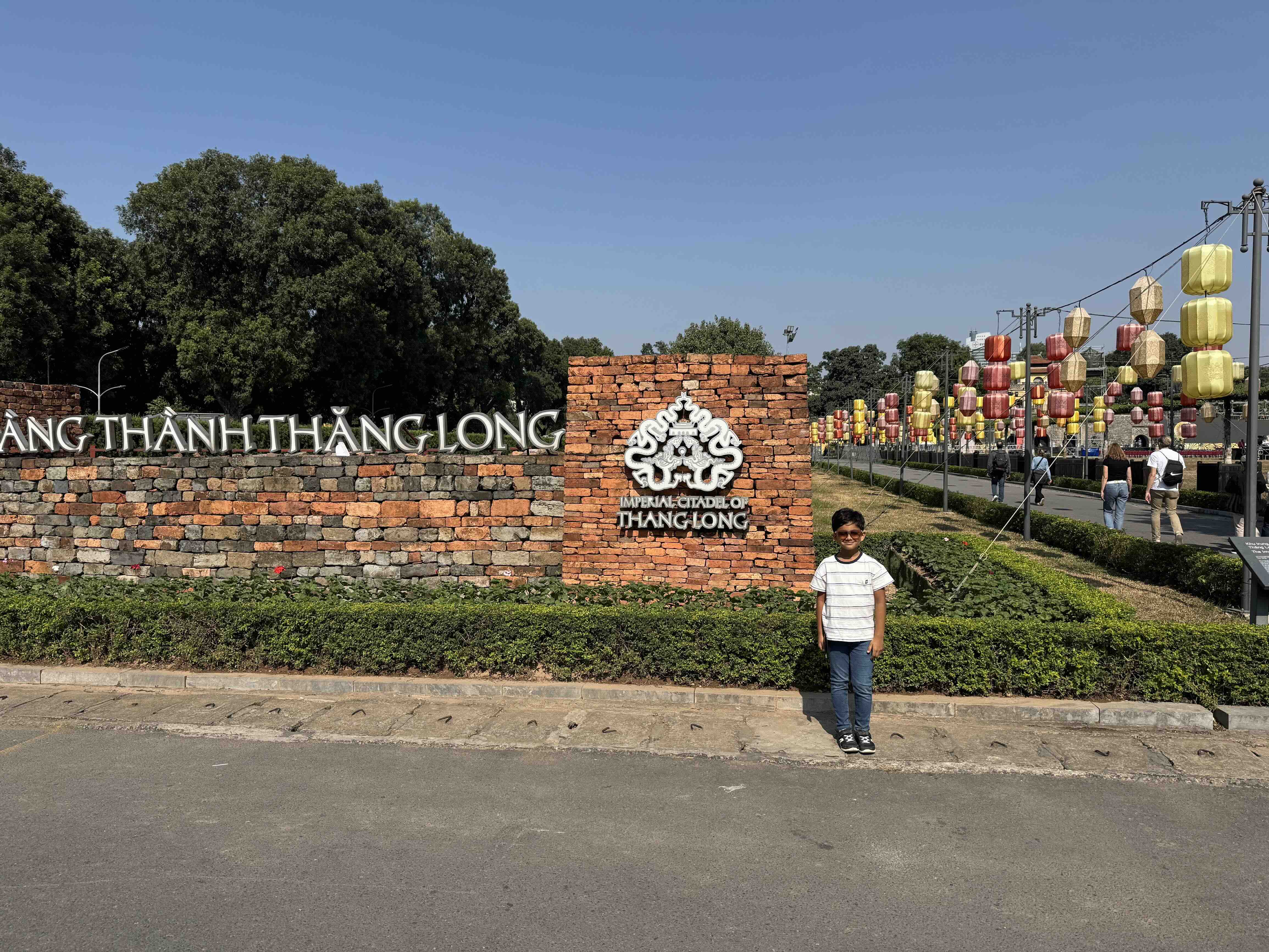

After that we went to the Vietnam Museum of Ethnology, a museum that shows us the lives and traditions of a few of the ethnic groups of Vietnam. The indoor area of the museum features artifacts and photos of the 54 ethnic groups within Vietnam, each coming from their own distinct places, with their different cultures and beliefs.
The outdoor area exhibits different kinds of Vietnamese homes on full scale. We saw a long boat said to be used for boat races in Indochina. People believed that the more races won by the boat, the more sacred it was. I observed a very interesting way of harvesting rainwater inside a house. The roof of the house was slanted, which allowed for the rainwater to fall into half a log of wood which would transfer the water into the well.
I also saw a communal house, where people would perform their sacred rituals. It was high above the ground so we climbed a ladder made out of a massive tree trunk to reach the top. Only men were allowed in these houses, and the law was that nobody in the village could have a house bigger than the communal house. The house was made completely from bamboo stems and leaves. I found it amazing that these thin trunks could hold up a whole house!


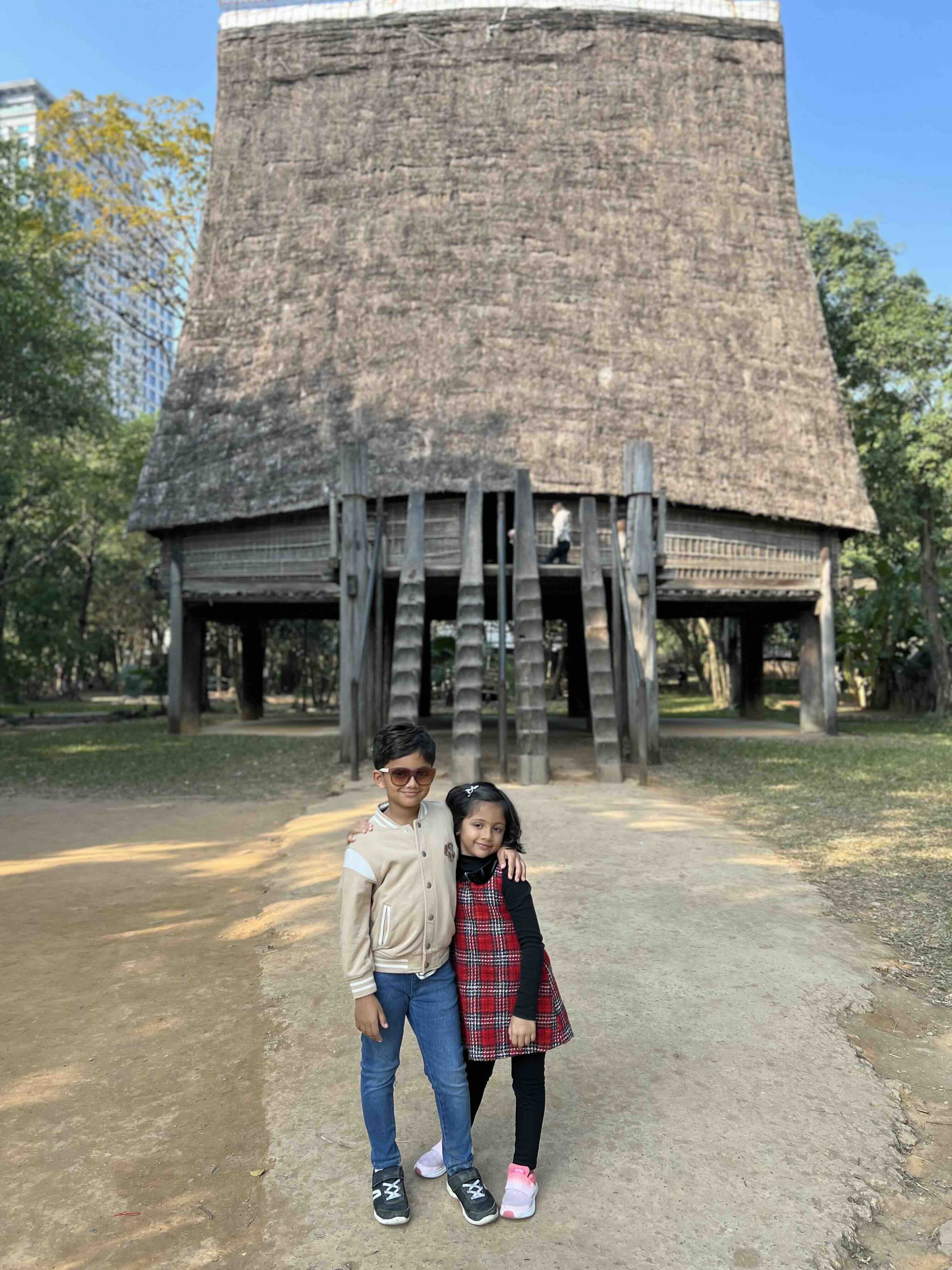





After this visit, we were all tired so we went back to the hotel. For dinner, Rebekah had ‘Pho’, a noodle soup served with beef, veg and other kinds of fillings. In Vietnam I understood that this is typically breakfast food.
On our second day in Hanoi, we visited the old quarter, the old city of Thang Long. In the past, the old quarter had 36 different streets with each street selling different wares. One street sold silver, another, bamboo for rafts and poles and the third, silk and fabric, and such. It was a public holiday, the roads were closed in some areas, people were enjoying themselves, and kids were riding on electric cars or tricycles. There were many people selling snacks and my mom bought some spiced mango, a speciality of Hanoi. She also bought a tissue box cover as Vietnam is well known for its embroidery, some Vietnamese coffee, and some silk bags as Vietnam is very famous for its handmade silk.
We then visited Hoan Kiem Lake (Sword lake). Over the lake was a red bridge which you can cross to get to a temple. This temple is dedicated to a turtle, there is in fact, a myth about this turtle.
Per the myth, the king of Vietnam was at war with his enemies, and one day when he was on the lake, a turtle rose from the water and gave him a sword which he used to defeat his enemies and bring peace to the country. After that he returned the sword to the turtle and named the lake Hoan Kiem Lake. In the temple, there were two preserved bodies of the species of turtle that was in the myth. Only six of this species remain in the world today. The turtles were huge, almost as big as I was!


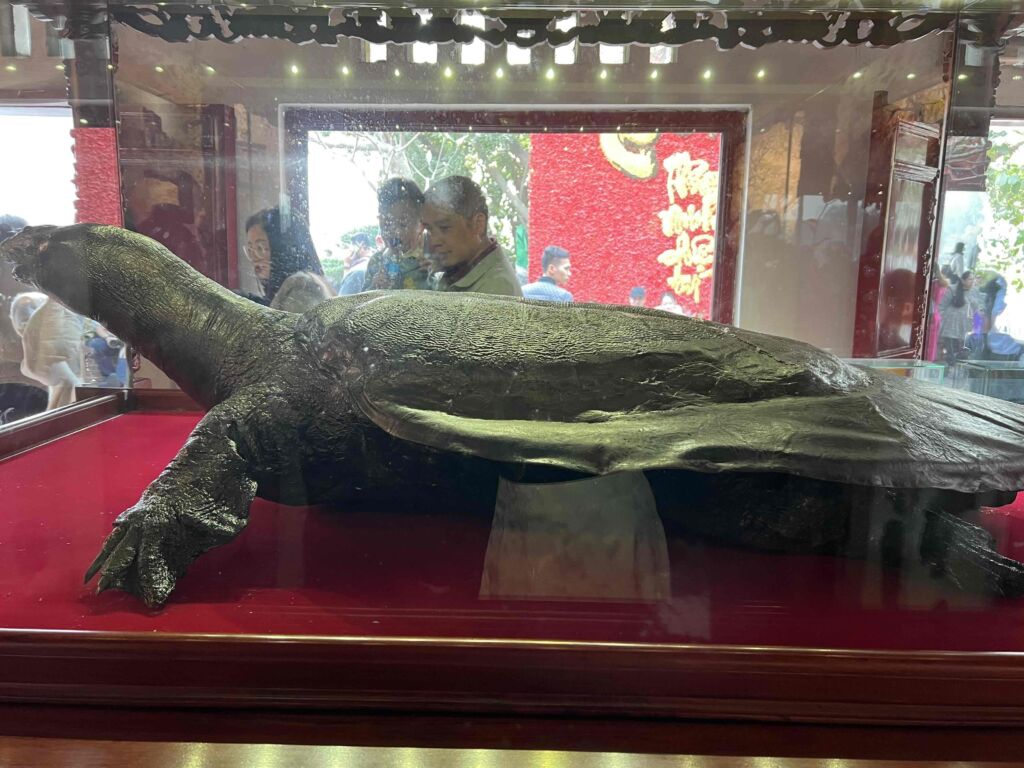

Soon, we were all starving so we decided to take a lunch break at a Banh Mi restaurant. Banh Mi is a traditional Vietnamese dish made from baguette which the French brought to Vietnam and the local Vietnamese fillings. I had a meatball Banh Mi.


Next, we went to a water puppet show at the Thang Long Water Puppet theatre. This is a traditional Vietnamese puppet show, formerly performed by farmers during the flood season. They are called water puppets because the puppets are maneuvered over the water. We got audio guides to help us understand the story as it was all in Vietnamese. The stories were really interesting; my favorite one was about a fox trying to eat ducks. Each day, it would sneakily try to evade the owner and catch one of his ducks. In another scene with dragons swimming in the water, fire actually came out of their mouths!






To close the day, we went to ‘Train Street’, so named because the train runs right through the middle of the street! Some of the houses and cafes on this street are less than a meter from the train tracks. Imagine living in one of those houses. The train runs right outside their window. Tourists come here to enjoy snacks and watch the trains pass by.
Ninh Binh: Day trip from Hanoi
You can stay in Ninh Binh but we chose to do a day trip instead. It was a hour and half long drive from Hanoi. Our driver told us that there are many mountains in Ninh Binh which are all made of limestone. People rear mountain goats in Ninh Binh mainly for their meat. We saw a lot of goat herds being led by their owners, and we even saw a few wild ones on the mountains.
Our first stop was the Hoa Lu Ancient Capital. There were several dynasties in Vietnam and after the Ngo dynasty (939 to 965) fell, twelve warlords each wanted the throne. Seeing the war threat, a man named Dinh Bo Linh undertook the mission of unifying Vietnam and defeated the warlords to become the next king of Vietnam. He moved the capital to Hoa Lu under the new Dinh dynasty.
There were many temples in the complex and lots of offerings for the deities, like beer, oranges and incense. Outside, there were dragon beds, 2 ton stone beds with dragons carved all around. The king used to put a mattress on and sleep on the bed. Outside the temple, we saw a bronze palanquin that the king used to ride. We also saw a huge buffalo, all dressed up so others could ride it or take photos for a price.
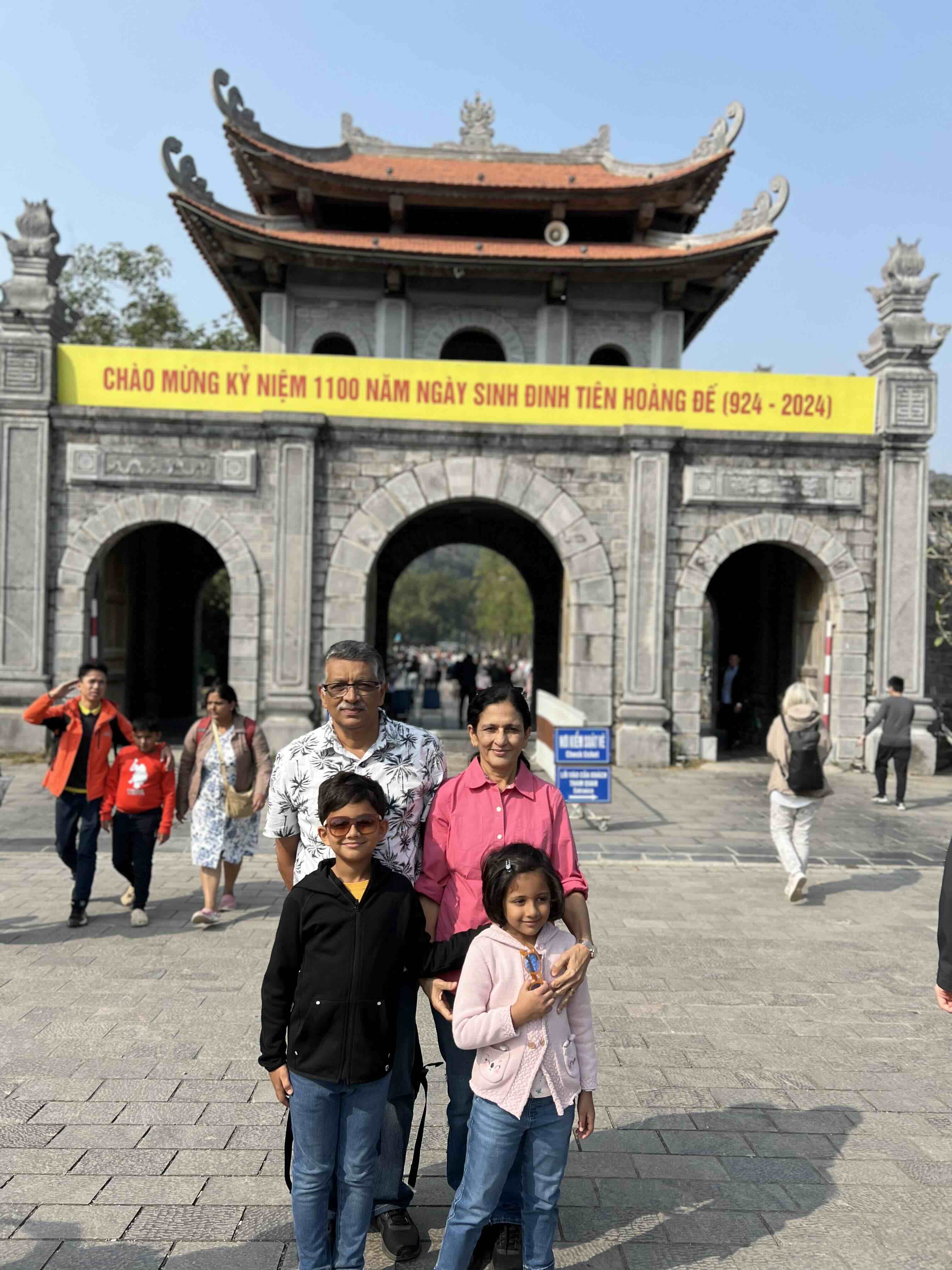



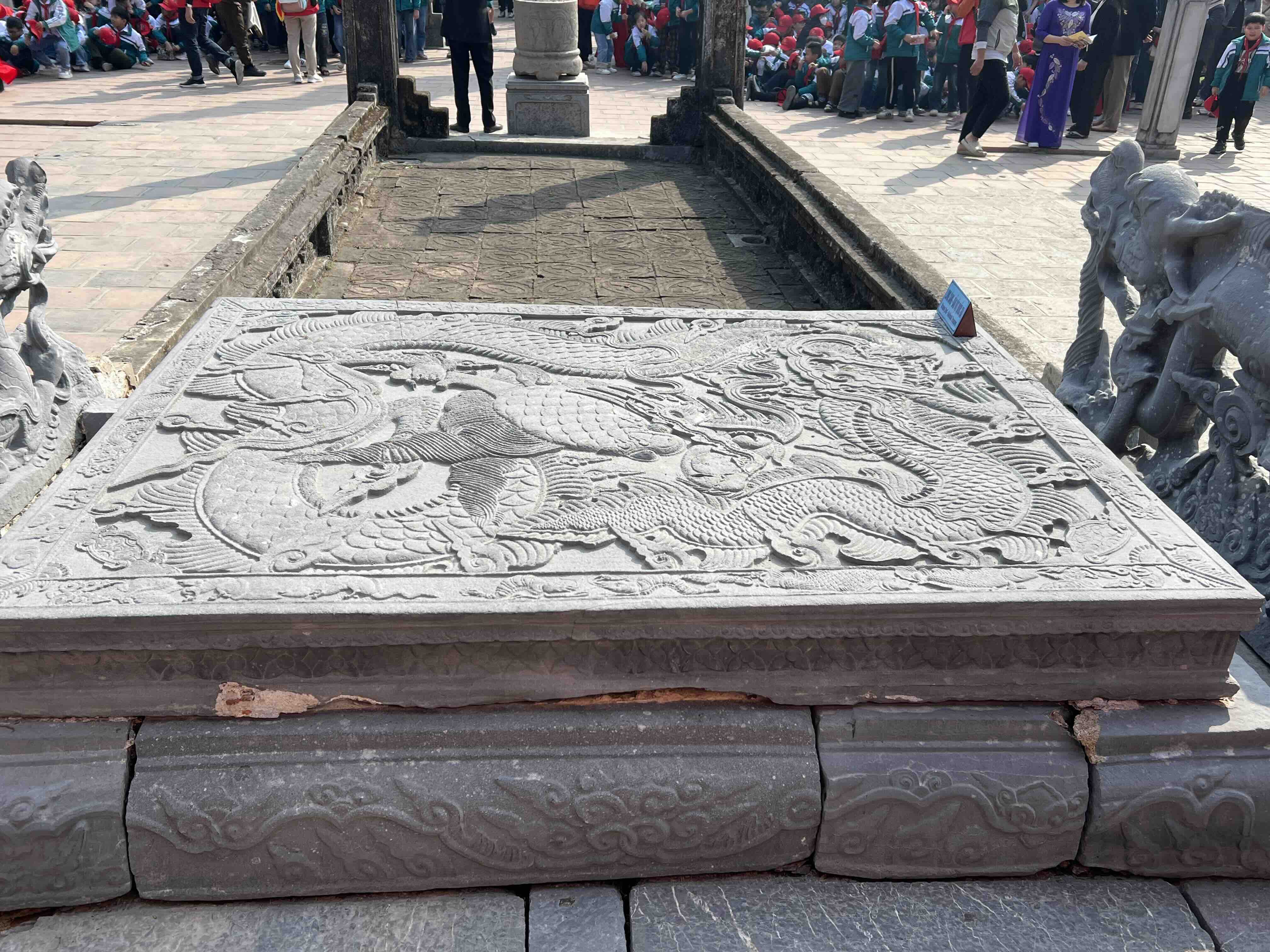

Next, we went to the Mua Caves. There are two small caves that you can visit, but the people come here mainly to climb 400-500 steps to reach the top of a mountain. There are two paths, the first, with 500 steps, which takes you to the dragon temple which has a long statue of a dragon, and the second, with 400 steps, that leads to a pagoda – this was the one we took. As I was climbing up I saw everything below me getting smaller and smaller. There is a majestic view from above. You can see the whole area of Ninh Binh with the many limestone mountains surrounding it. At the foot of the mountain is a huge lotus field. There weren’t many lotuses there as we had come in the winter. Then we went for a well earned lunch. I tried a specialty of Ninh Binh, goat meat with rice which I really liked.




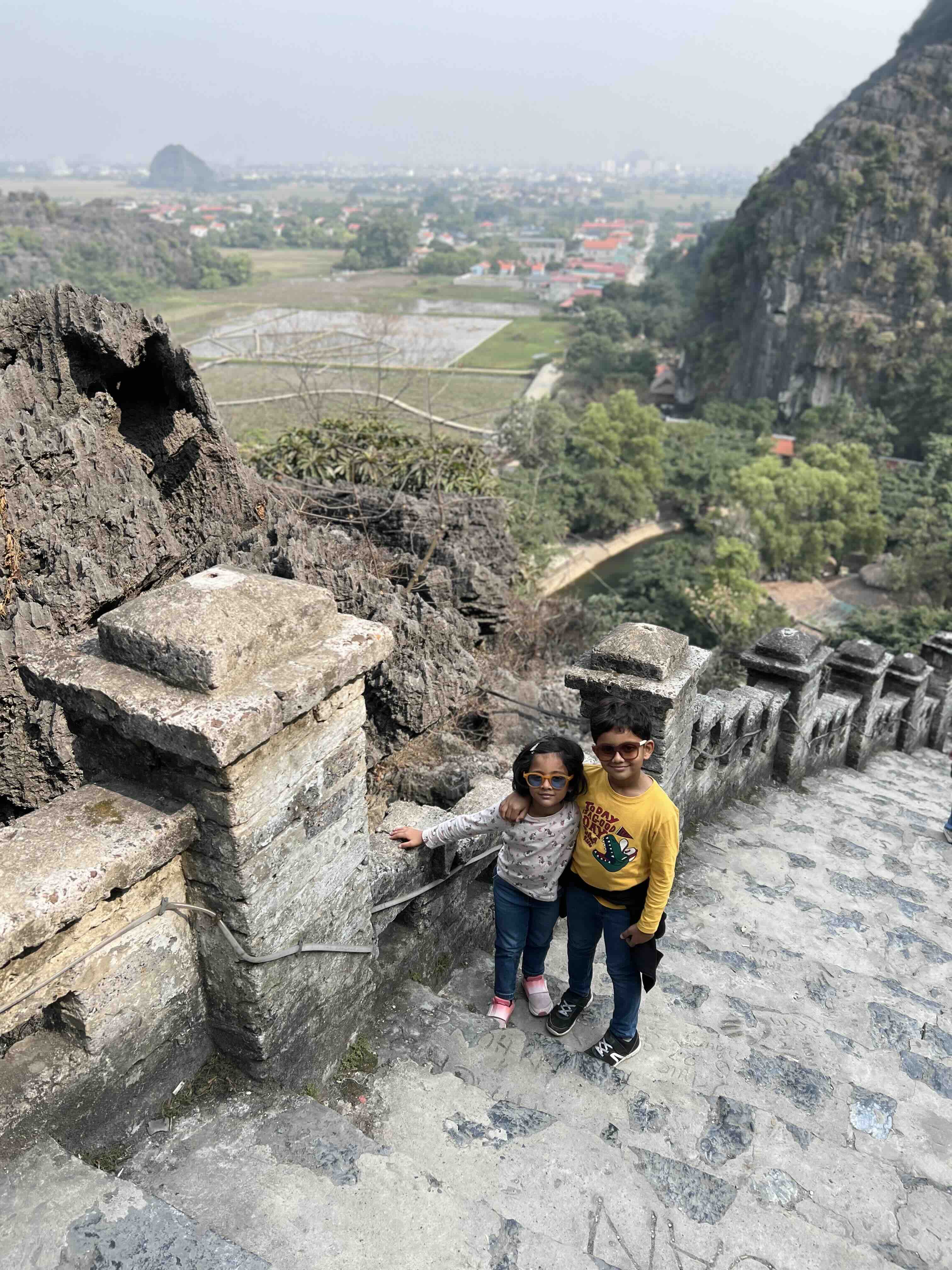



Towards the end of the day, we went to Trang An. It is a complex of limestone mountains. A river cuts through this and you can row boats through the caves in the limestone mountains. There are three routes you can take but we took the second one, with a total of four caves. The boat can only fit four people and a driver who rows the boat with long bamboo oars. We had to split into two boats, my parents in one and us with our grandparents.
In the caves, I could see loads of stalactites hanging from the ceiling, a few of which I was able to touch. We decided to race our parents and I rowed the boat almost the entire time trying to overtake them. I knew this would be one of my most favourite experiences because I got to row the boat too!




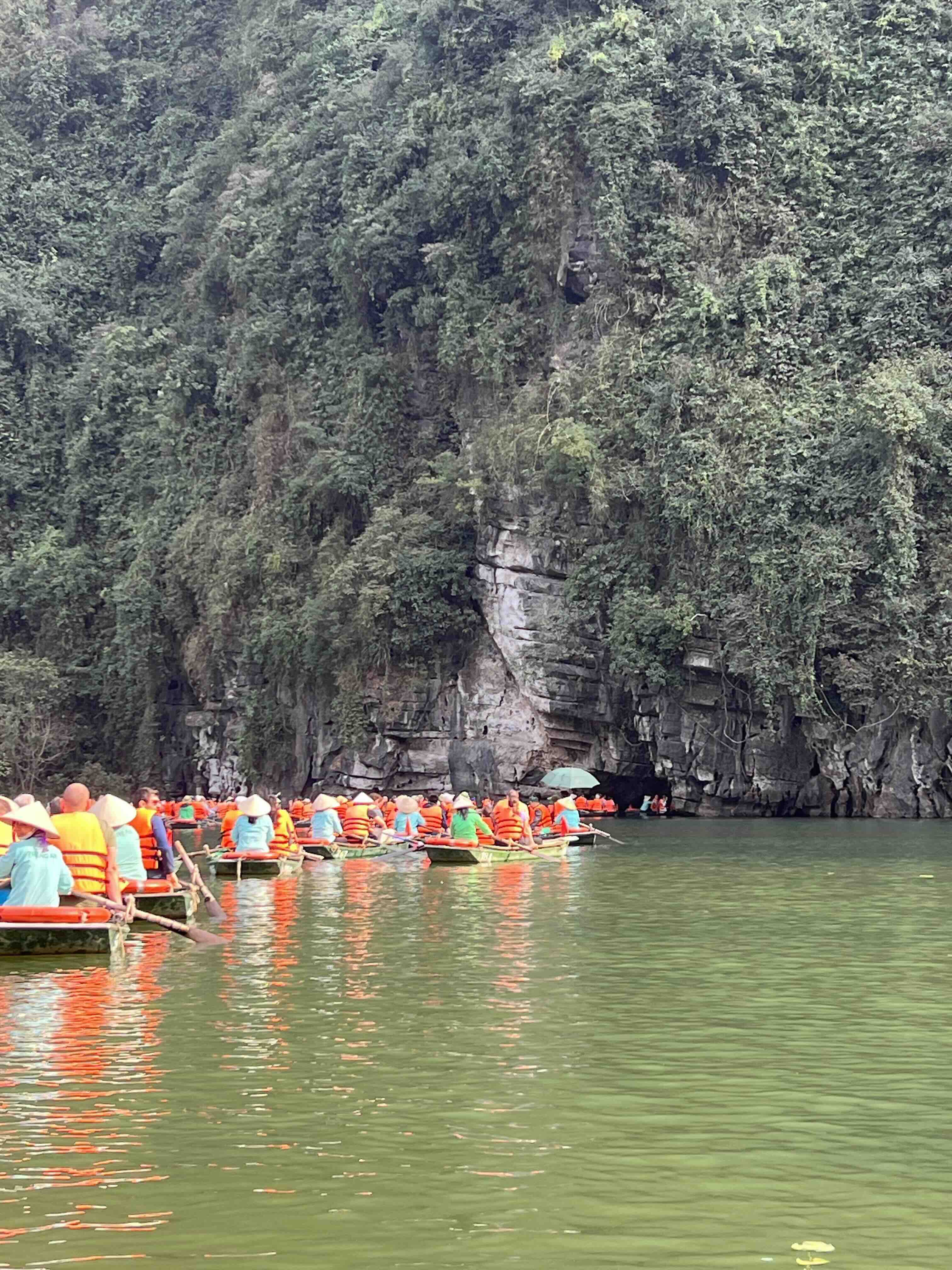

Halong Bay: 2 days and 1 night
To go to Halong Bay we first took a 3 hr bus from Hanoi to the port in Halong Bay. En-route to the port, we went to a pearl farm where we saw the process of extracting pearls from an oyster. To make a pearl, they would take out the tissue from another oyster and put it in the first oyster along with a shell. The oyster would react to this process creating a pearl in self defense. The creation of a pearl can take 6 years for a big pearl, 4 for a medium sized one and 1 for a small oyster. I learned that pearls come in many different colours and can be used to make a lot of things like jewelry and beauty cream.
At the port, we took a mini boat to the Dora Cruise, our home for a night. While on the mini boat, our guide gave us a briefing and told us more about Halong bay. Like Ninh Binh, Halong bay is full of limestone rock formations except that they’re all in the sea. our captain said there were around 200 of them in Halong Bay. I also saw lots of people collecting barnacles on the shores nearby as it was low tide.


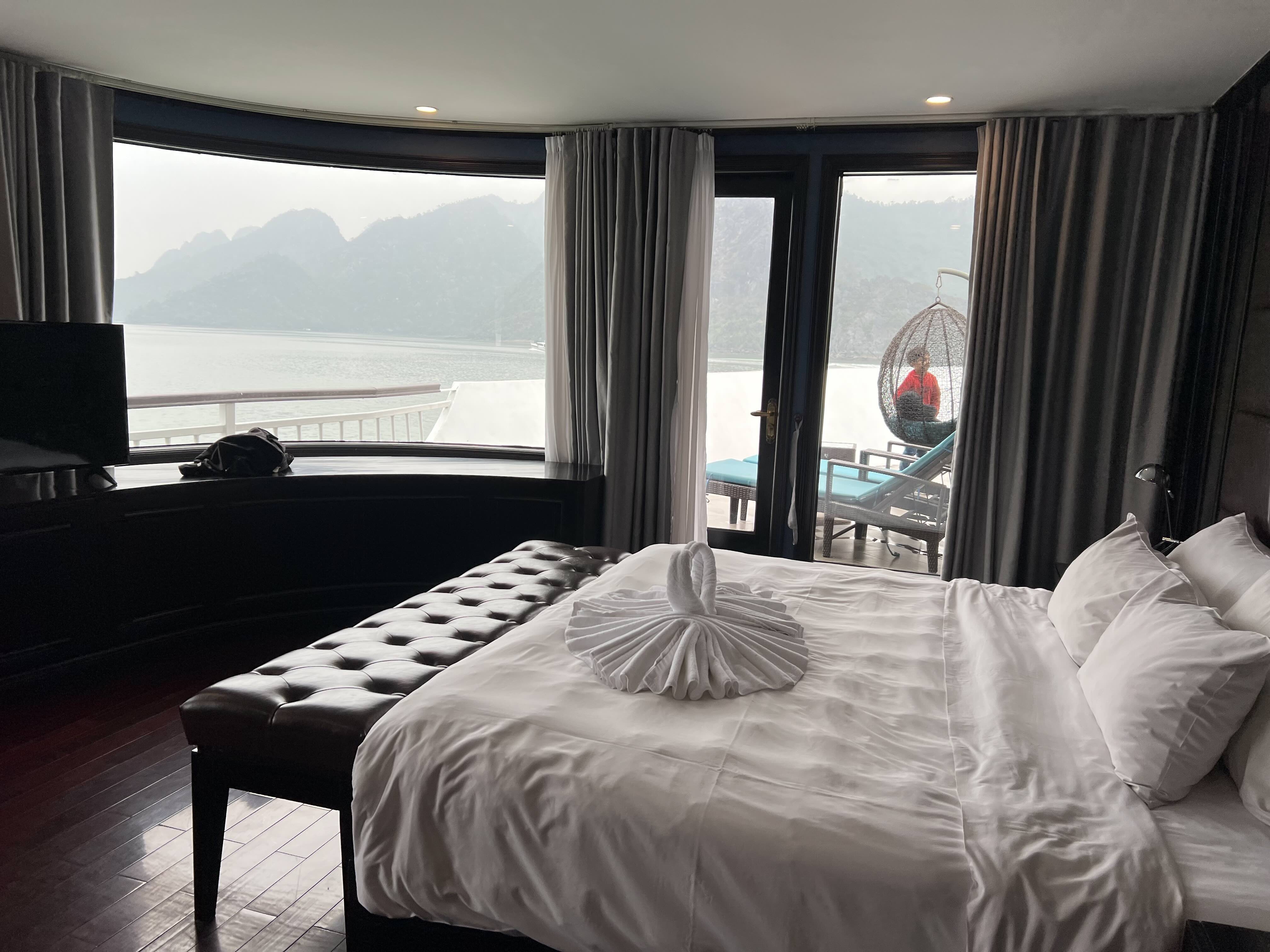



At the cruise boat the whole crew was waiting there to greet us. The cruise had three floors. All floors had rooms to stay, the first floor had the reception and the docking for small boats like our mini boat and the third floor had the restaurant, the gym and the spa. Above the third floor is the upper deck, the highest place on the ship. There is another lounge as well as a super warm jacuzzi, since we didn’t have swimming clothes we couldn’t go. You can also go to the captain’s cabin to watch the captain drive.
There were many activities on the ship as well as card and board games. I made a friend, Dev, who I played chess with; I lost to him almost all the time – he was that good! After that, we went for a spring roll making activity. I put a lot of meat in mine but didn’t succeed in making an actual roll. When I rolled the rice paper up, it was quite loose so all the fillings came out.
After dinner, we went squid fishing. You were basically supposed to move your line up and down in the water to try and imitate a fish so the squid would bite the line, but it was hopeless. Though we saw a squid moving through the water, and a few fish, we didn’t manage to catch any.


The next morning after breakfast we took the mini boat to the Dark and Light caves. We went on a boat with Dev and his father. We couldn’t go to the Dark cave because it was too dark. We only went through one short cave (Light cave) that was passing through a rock formation. My dad was the biggest that almost everybody had to sit on the other side to balance the weight of the boat!
After coming back, we had an early lunch, and started packing up to leave the cruise. Soon we were on the mini boat and heading for the port. After saying goodbye to Dev, we took a 3 hr drive back to Hanoi.
Sapa: 2 day itinerary
You can travel to Sapa from Hanoi by train or by car. We took a sleeper train to Sapa. The sleeper train is an overnight train, sort of like a moving hotel. The rooms were all on one side and each room had two bunk beds. In my grandparents room, the top bunks were raised so that there were only two beds.
As we started moving, I realised we were heading to ‘Train Street’. The chairs and tables in the cafes on the street looked super close to us and I could even see through some of the windows in the houses. We then moved to a bridge and there were cars and motorcycles riding right next to us! The next morning, we woke up at around 5:00 am as we had arrived in Sapa. It was freezing cold.
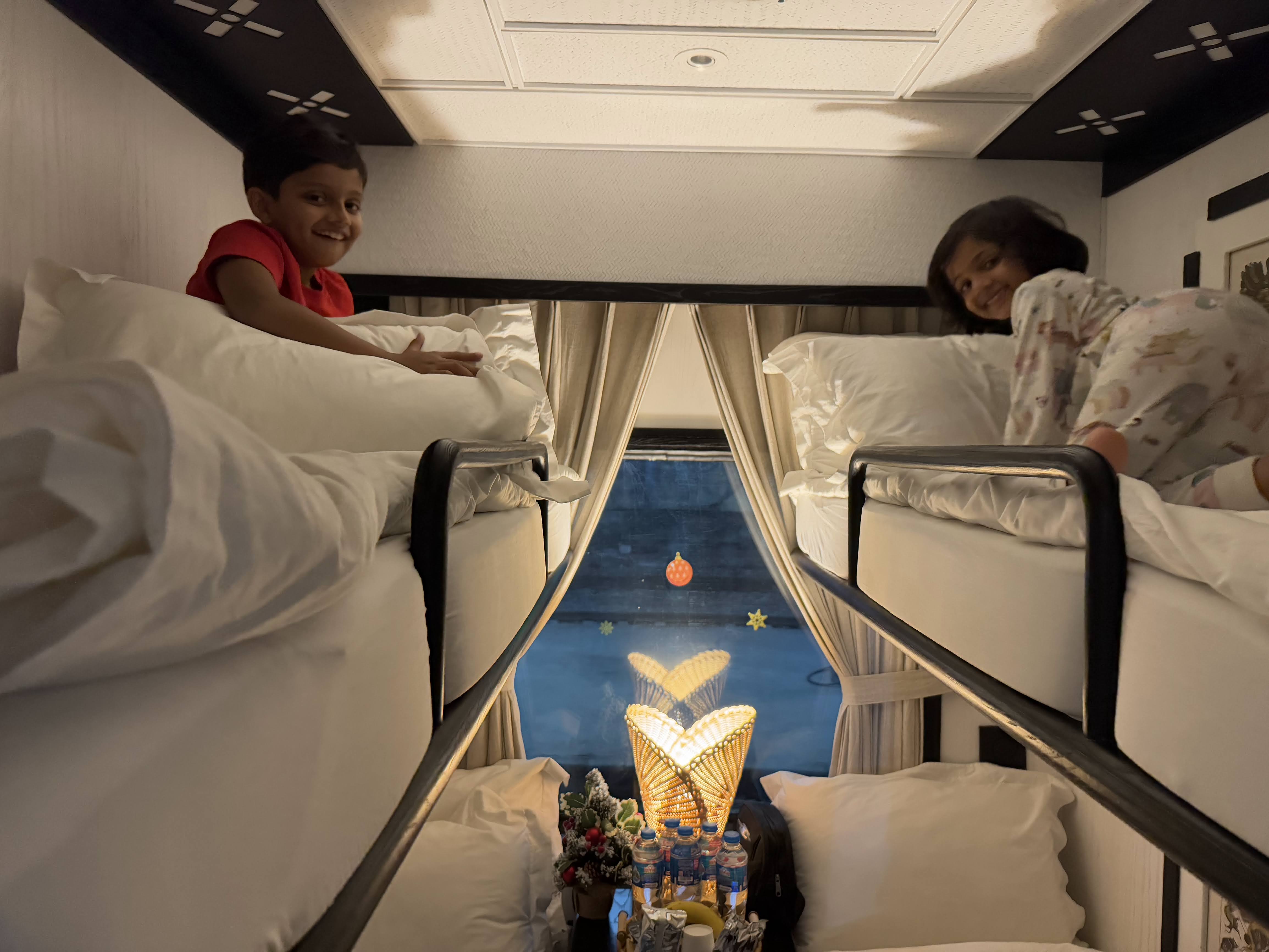

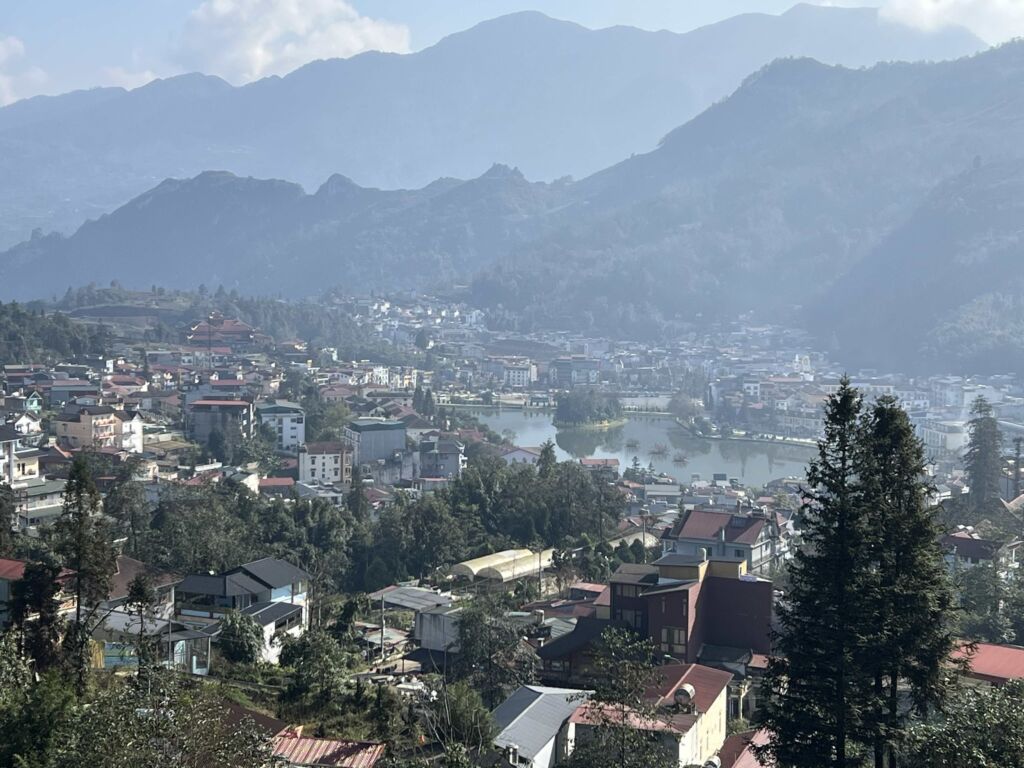

We got a cab to our resort, the Silk Path Grand. On the drive, we saw many mountains, in fact, we were even driving up one! There were lots of paddy fields on the slopes and they looked beautiful. My mom said that Sapa is the residence of many of the ethnic groups of Vietnam such as the H’mong and Red Dao people. Our room in the resort wasn’t inside the main building. Instead, we had our own bungalow!
After settling in, we went to see Mt. Fansipan, the highest peak in Indochina (includes Vietnam, Laos, Cambodia and Thailand) which is 3,143 meters above sea level.
There are three segments of the trip. The first is from Sun Plaza, a funicular station to the cable car station. I could see the train going up and felt my body slanting but I held onto the railing. My dad told me that the train moved because of pulleys and that there were two funicular trains. The view from the train was beautiful. I could see the mountains, paddy fields and maybe even the village of Sapa.




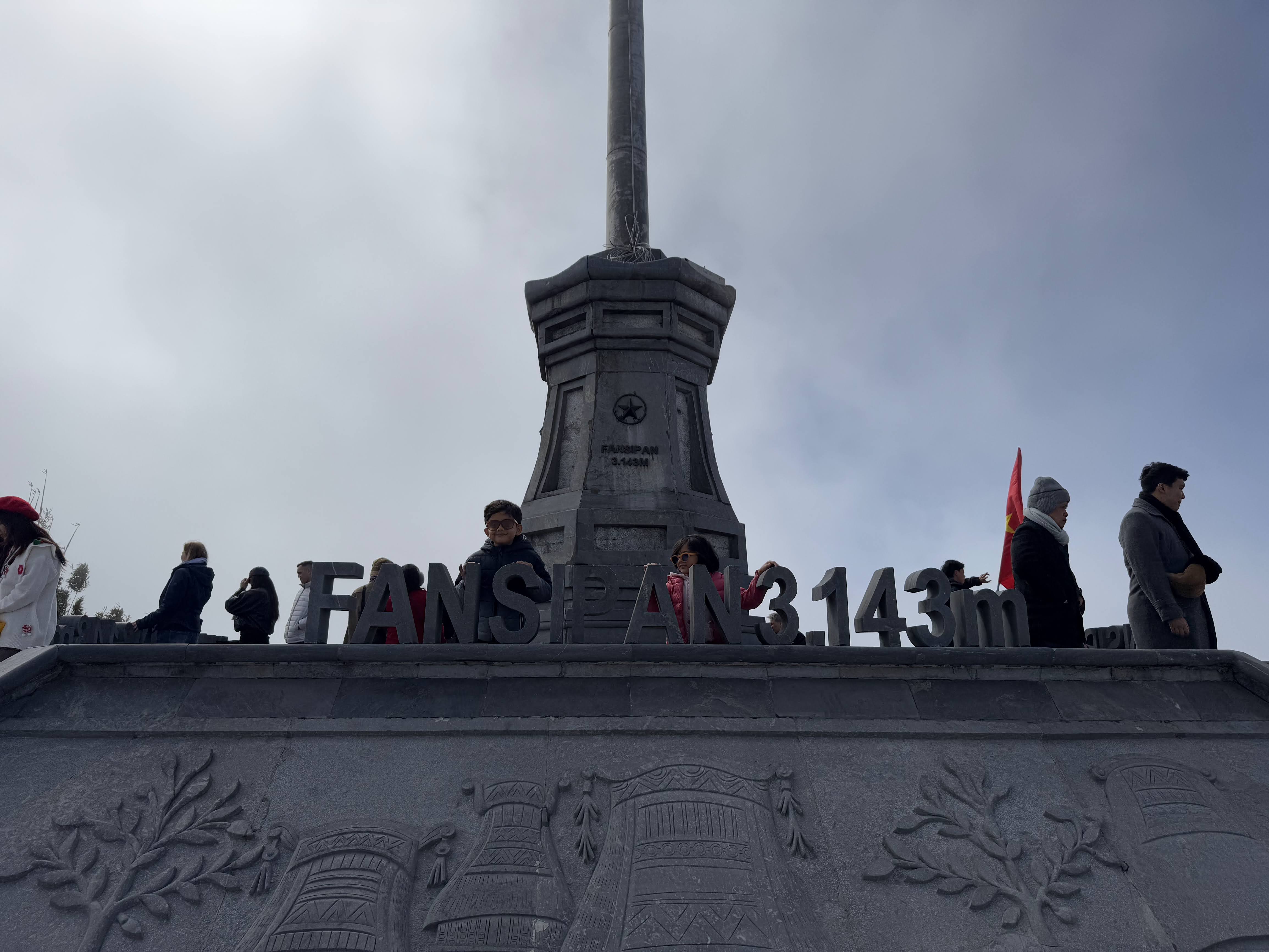

For the second segment, we took the cable car to around 3000 meters from the top. Soon, we were in the clouds! I couldn’t see anything as the whole area was just white. It looked like the cable was going to end! At the top of the cab car ride, there were a couple of temples dedicated to the Buddha. The final segment of the trip is either a 600 step climb to the summit or another funicular train ride.


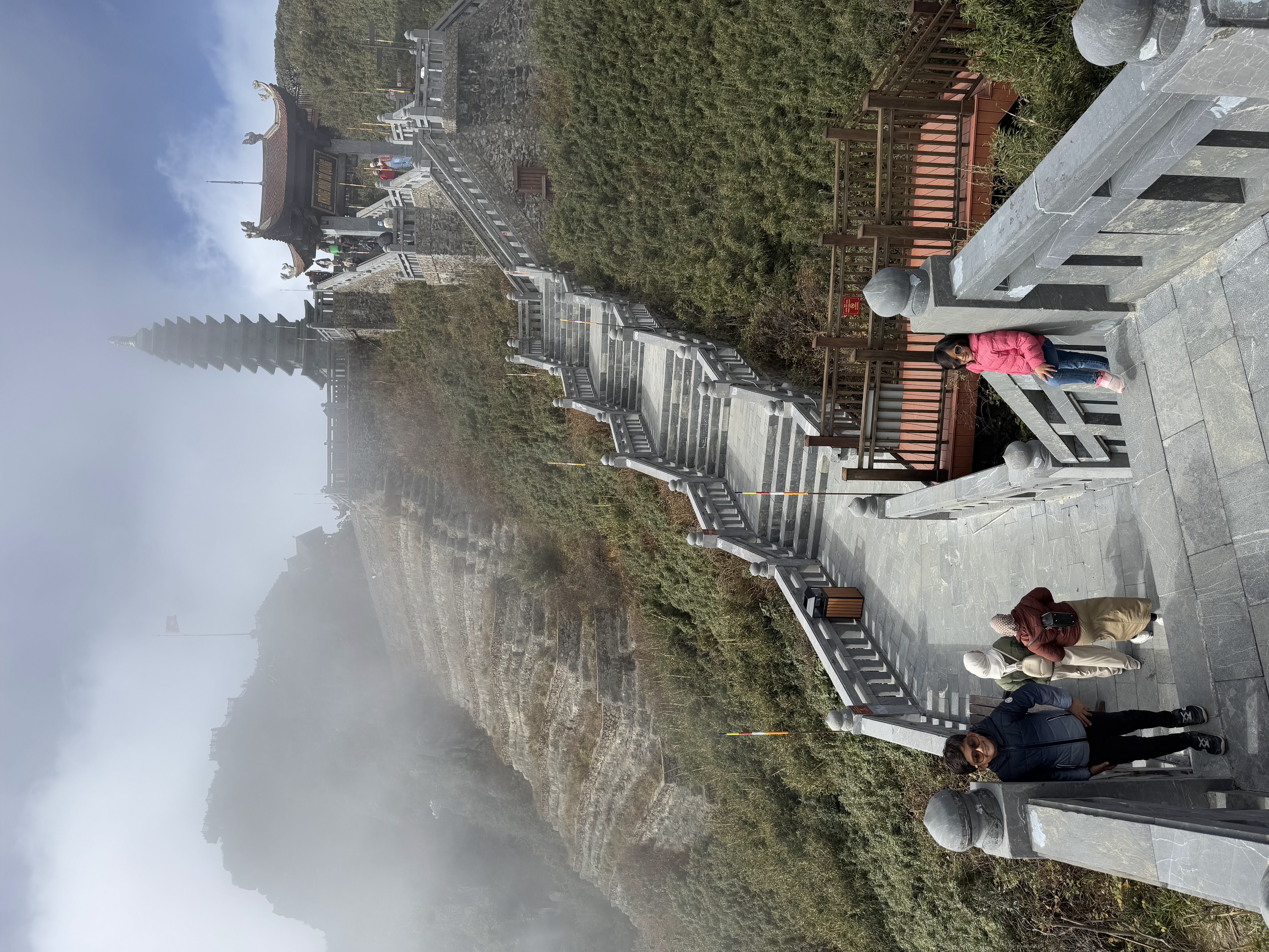

At the summit, we could see an elevation marker on the peak of Fansipan. I was 3,143 metres above the ground, the highest I’d ever been before! Unfortunately, I couldn’t see China and Laos, the closest countries to Sapa because it was too cloudy but I could see the huge Buddha and Bodhisattva statues near the temples. Soon, we were back at the bottom in Sun Plaza and going back home for a well earned rest.
The next day, we had an early start to get to the Rong May glass bridge. We took a glass elevator to the top of the mountain that the glass bridge was on. It was so scary to look down as the floor was glass. If somebody wore high heels, they would have to put shoe covers on to prevent scratches. Climbing the stairs was even scarier. There were gaps between each step so you couldn’t take such big steps.
Once, we were past the glass bridge, I saw many adventurous activities we could do. You could walk across the valley on a rickety bridge suspended in midair trying to step on the platforms and making sure not to fall off. Luckily, you would have a harness! There are also many photo spots with a picturesque backdrop of the mountains.
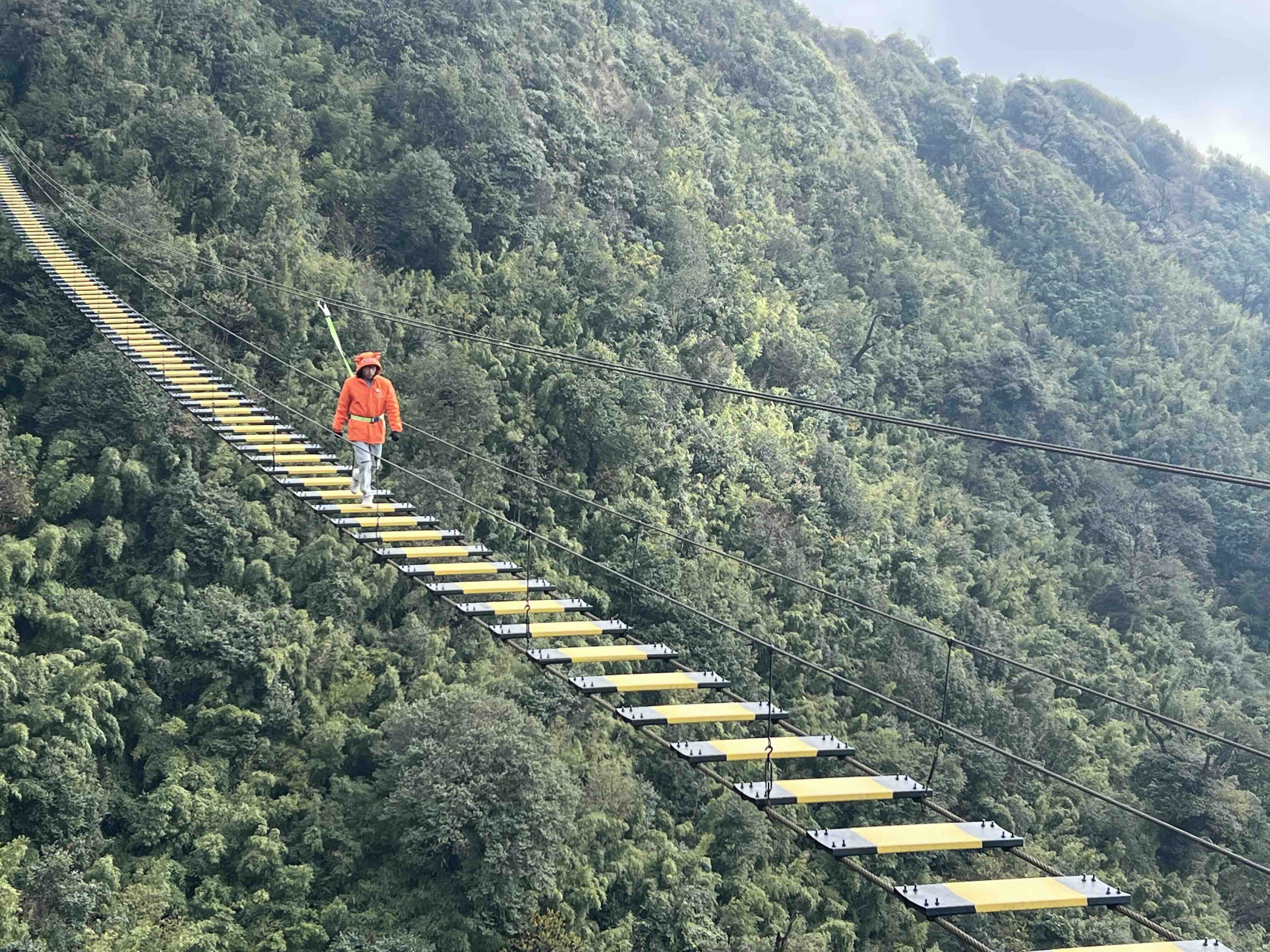

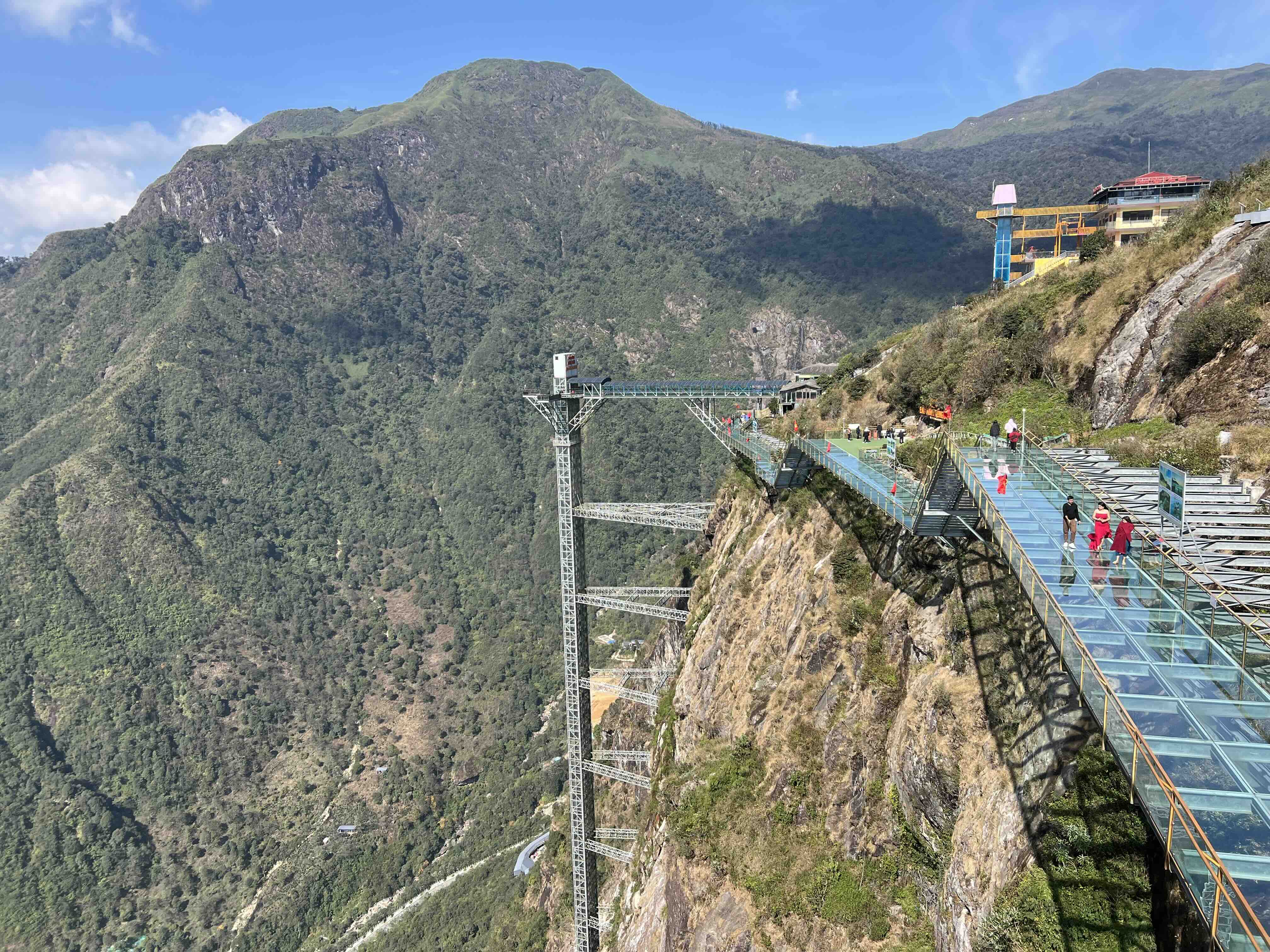

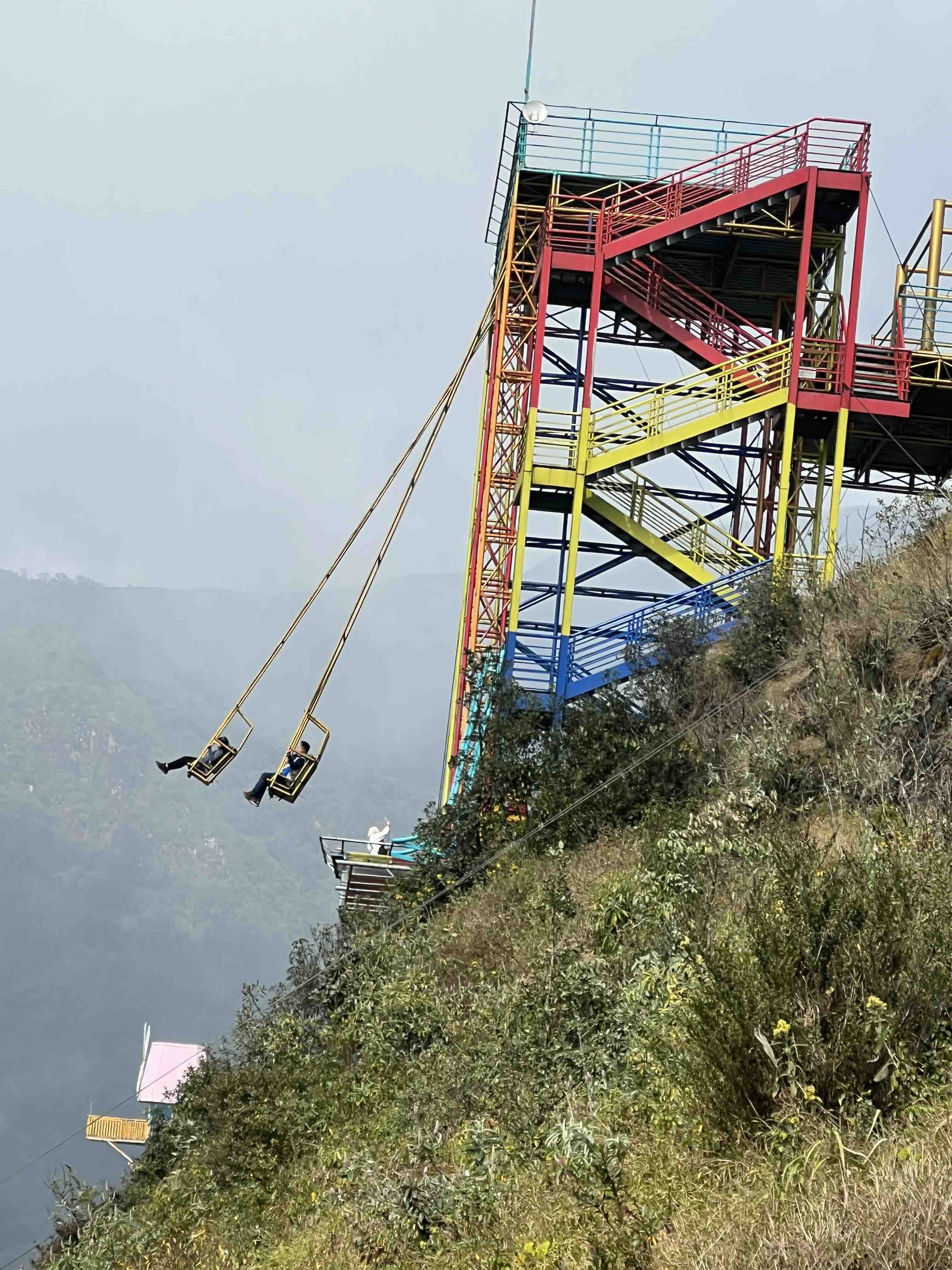

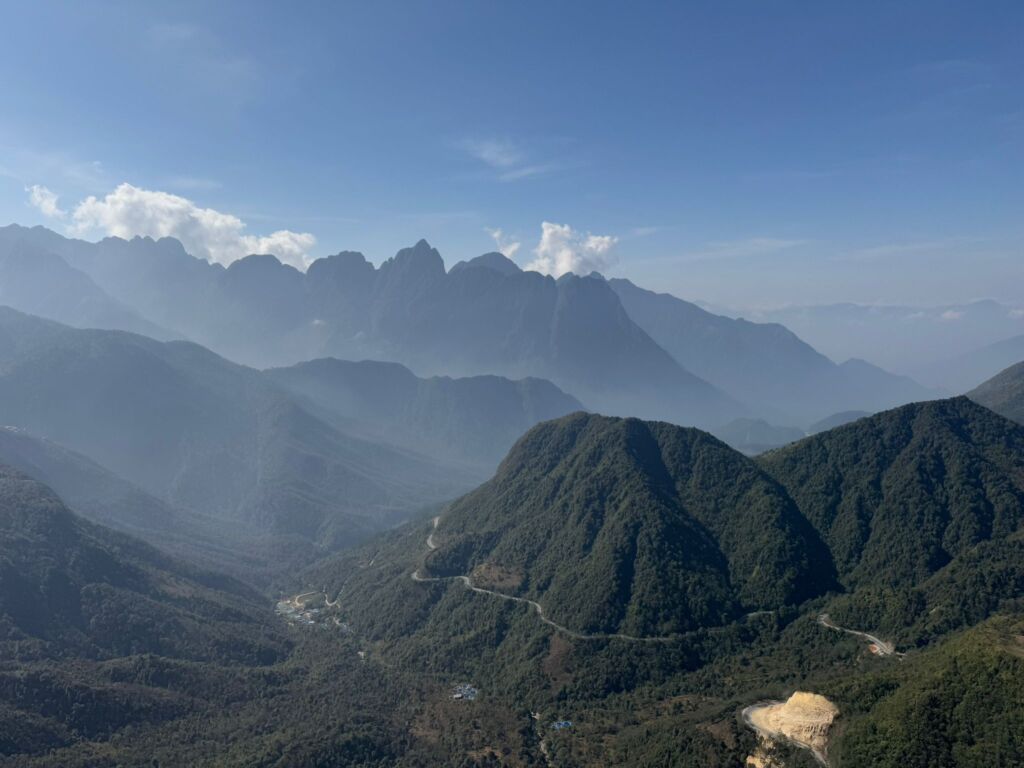

My sister wanted to go on a big swing that pushes off the mountain into nothingness, but when she saw it close up, she felt scared and decided not to go.
Our next stop was the Gates of Heaven. It’s called that way because it looks like you’re going through a gate into the clouds. It resembled the Gates of Heaven in Bali which my grandparents had been to. We saw a pond with statues of the four sacred animals of Vietnam around it and a peach garden, full of fake peaches and small statues of the four heavenly kings of Vietnam. Then, we went to see the ‘Love Waterfall’, but to get close to the waterfall, we would have to take a 4 hr hike up the hill and everybody was hungry, so we decided not to do it.
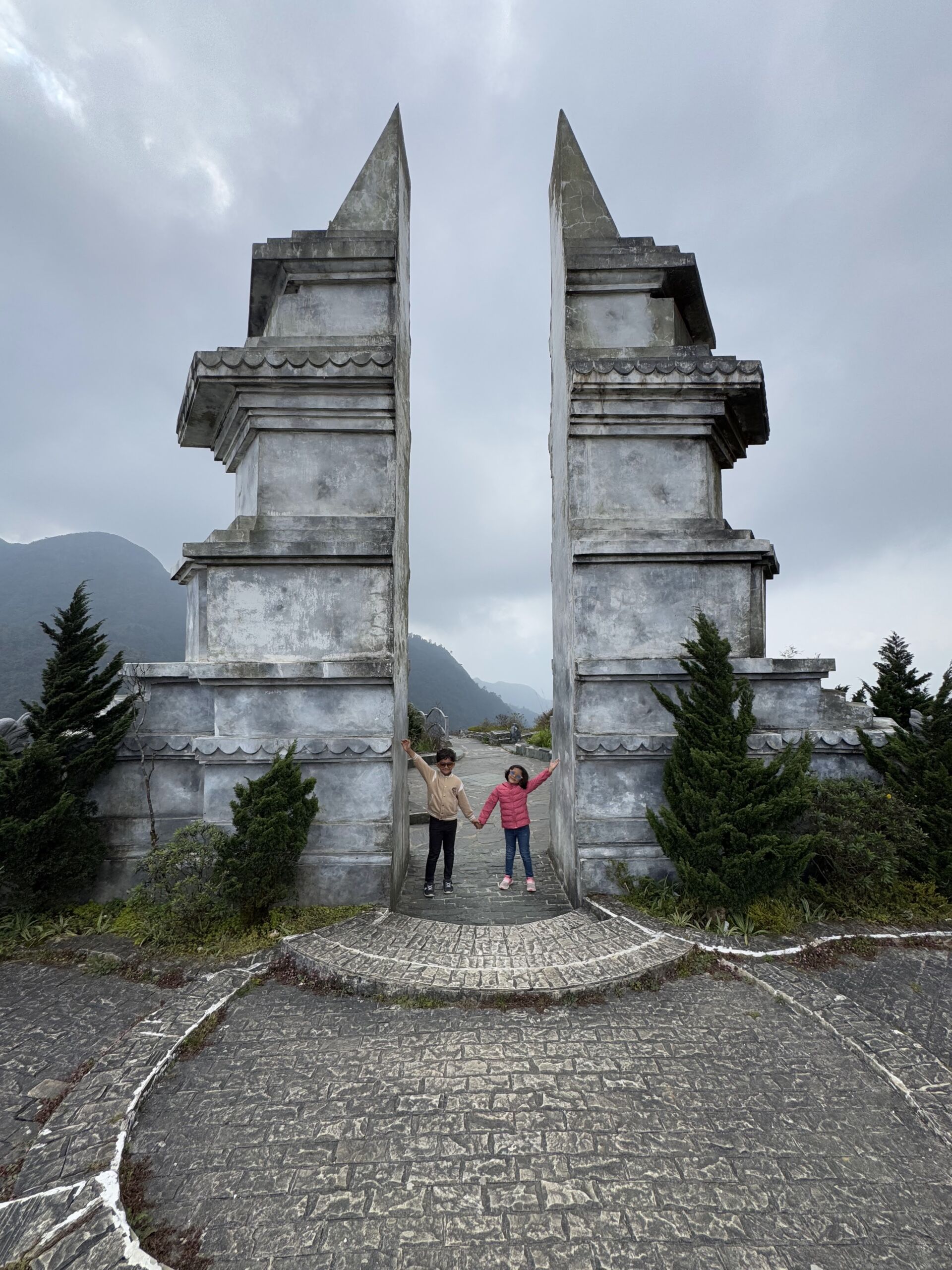

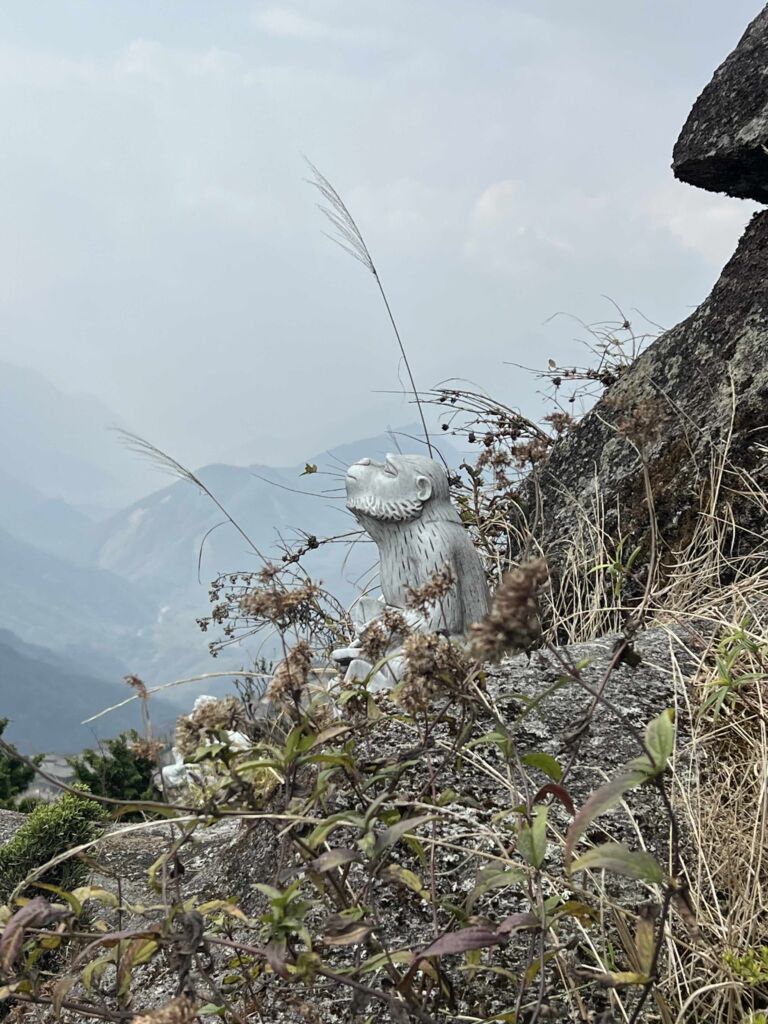

For lunch we went to a restaurant that served the local cuisine of Sapa. We had purple coloured rice, fried and then wrapped in a bamboo stem along with pork, smoked also, in a bamboo stem. I really liked the juiciness and tenderness of the pork. Outside, I saw a whole tank of sturgeon and trout which is used to make local dishes in Sapa
To end the day, we went to Cat Cat village, one of the local villages in Sapa. We saw many H’mong women dressed in colorful embroidered clothes with lots of gold and silver jewelry like necklaces and earrings. There were also many shops selling colorful woven bags and clothes as well as dried foods like buffalo meat and different kinds of herbs and roots. Sausages were being smoked over hot coals, drying from the hot air.


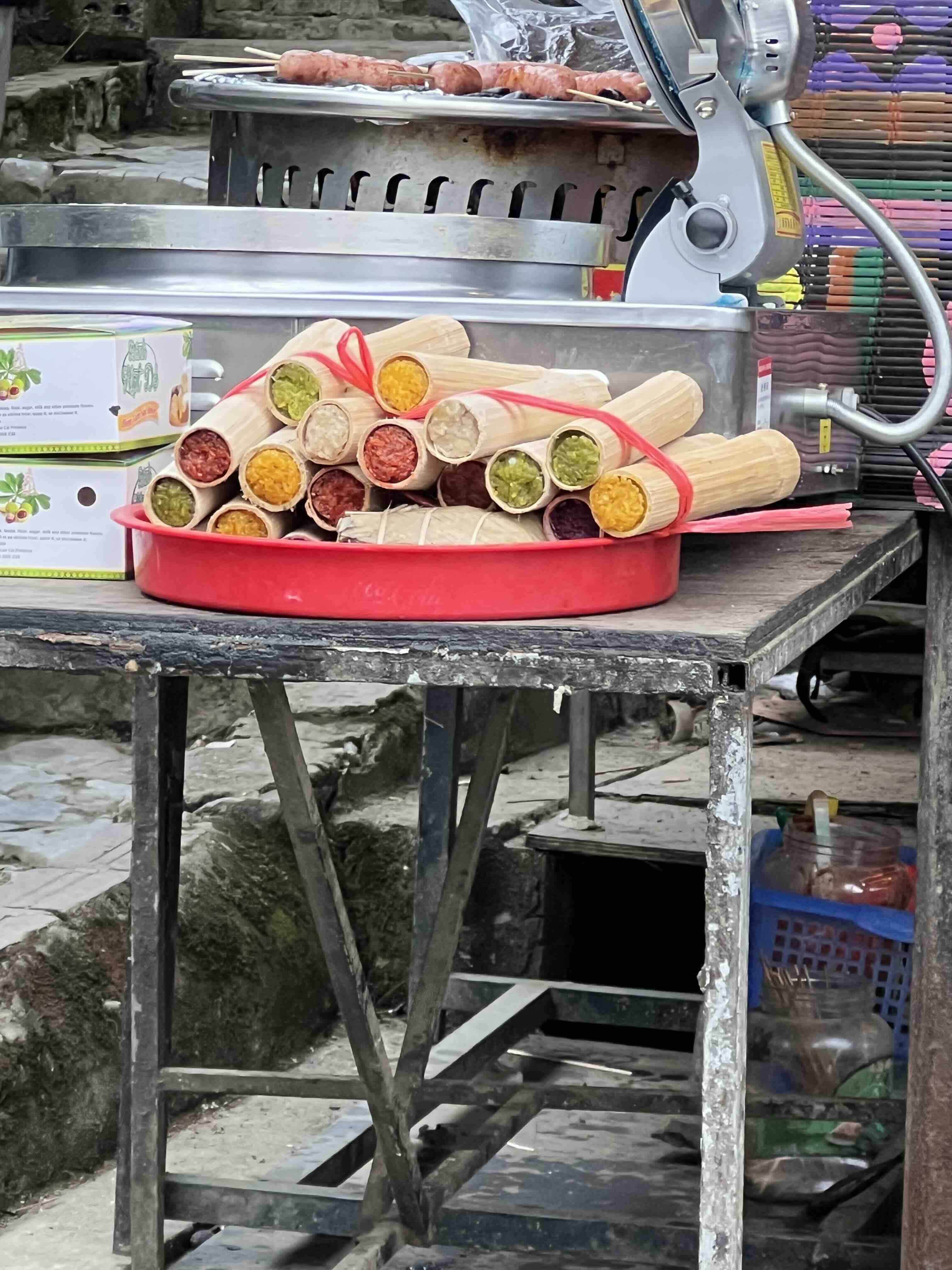

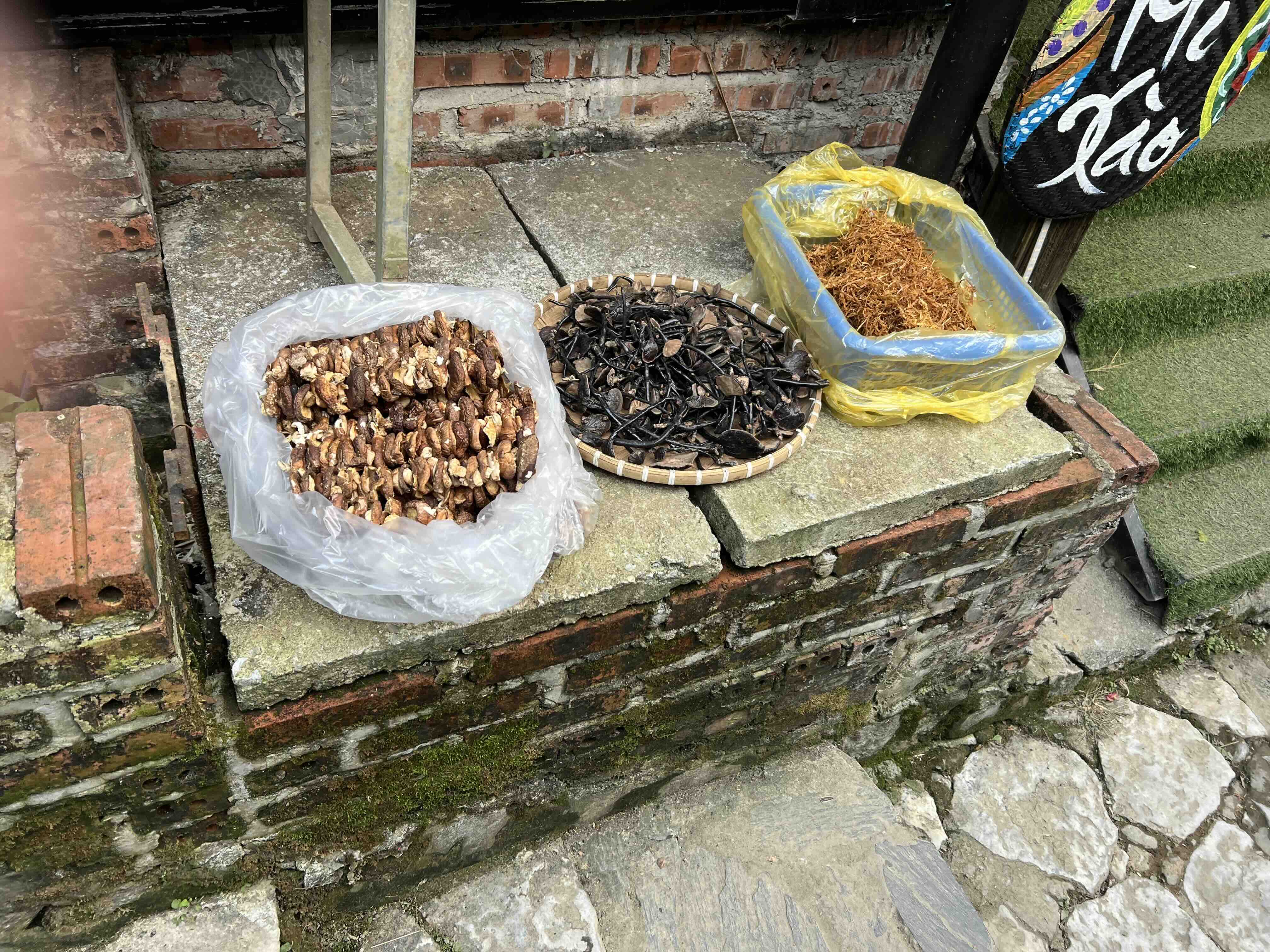

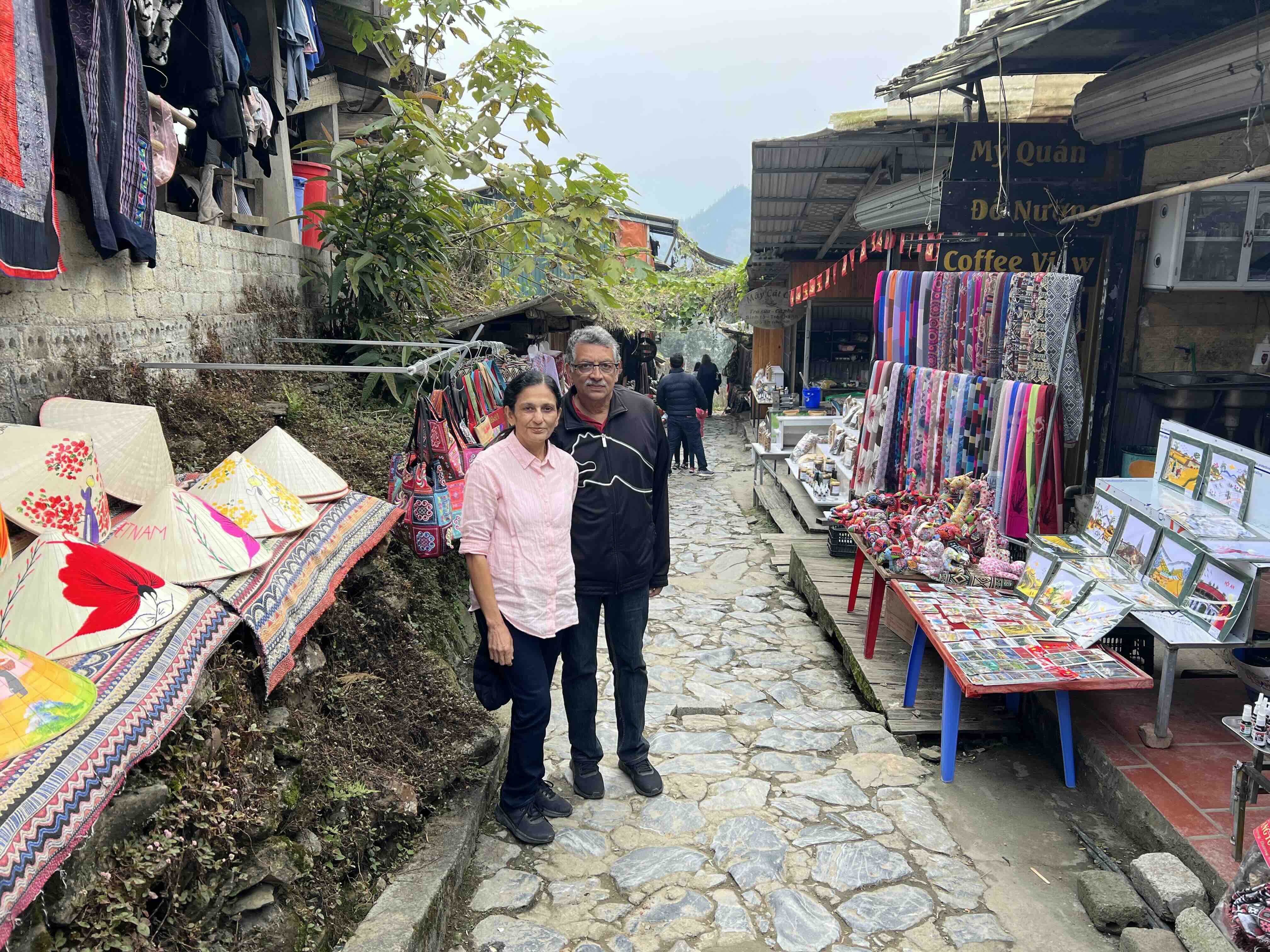

A dance was going on as well, people would move bamboo sticks to a rhythm and you would have to jump over them with a partner without falling. You would need extremely good balance to do that. We also saw a few cherry blossom trees. Considering it was the start of the year, those cherry blossom trees had bloomed really early. After the walk at Cat Cat, we decided to go home for a rest.
The next day, we arrived at Hanoi in the evening after a six hour drive to the airport hotel in which we would be staying for the night. Overall, I really enjoyed the trip. Halong Bay, Trang An and many other wonderful places. I look forward to visiting this marvelous place again. I would like to visit South Vietnam next time and see Ho Chi Minh city and the Mekong delta. Till then, goodbye!


4 Comments
Ms Dunne
George, another amazing blog post! This one has even more detail than the last one I read! I’ve been to Vietnam many times, and I especially love the Banh Mi’s! What was the name of the Banh Mi restaurant you went to? I think i’ve been to the same place 🙂 Even though I’ve been to Vietnam many times, i’ve never visited Sapa so i’ll definately return to your blog for tips the next time I go there on holidays!
Courtney
Loved the post, George; especially with all of the photos! It’s amazing you can make friends all over the world.
Roshini
“This travelogue is a delightful journey through the eyes of a young explorer! With vivid descriptions and heartfelt observations, it beautifully captures the excitement and wonder of discovering new places. The attention to detail and storytelling make it feel as if we are right there, experiencing every moment alongside the writer. For a ten-year-old, this is truly an impressive and inspiring piece of work!”
Roshini
“This travelogue is a delightful journey through the eyes of a young explorer! With vivid descriptions and heartfelt observations, it beautifully captures the excitement and wonder of discovering new places. The attention to detail and storytelling make it feel as if we are right there, experiencing every moment alongside George. For a ten-year-old, this is truly an impressive and inspiring piece of work!”